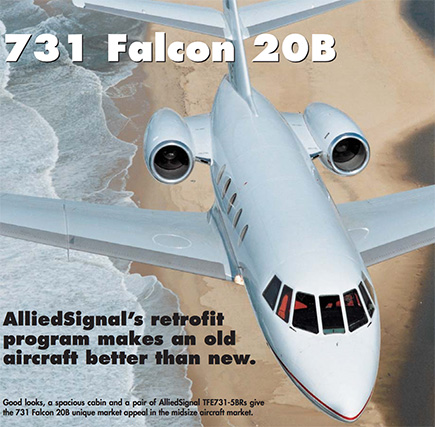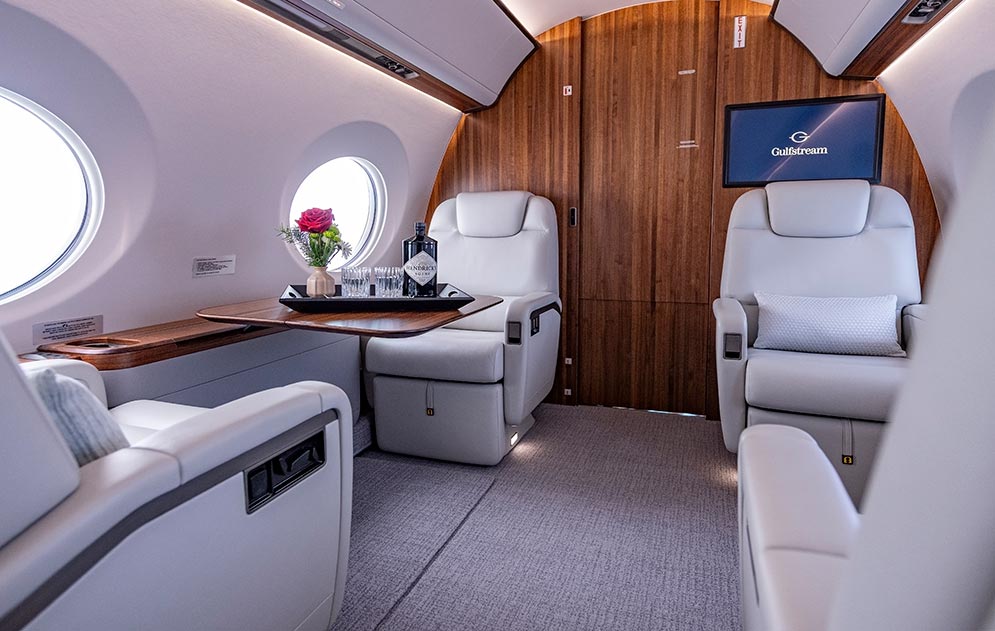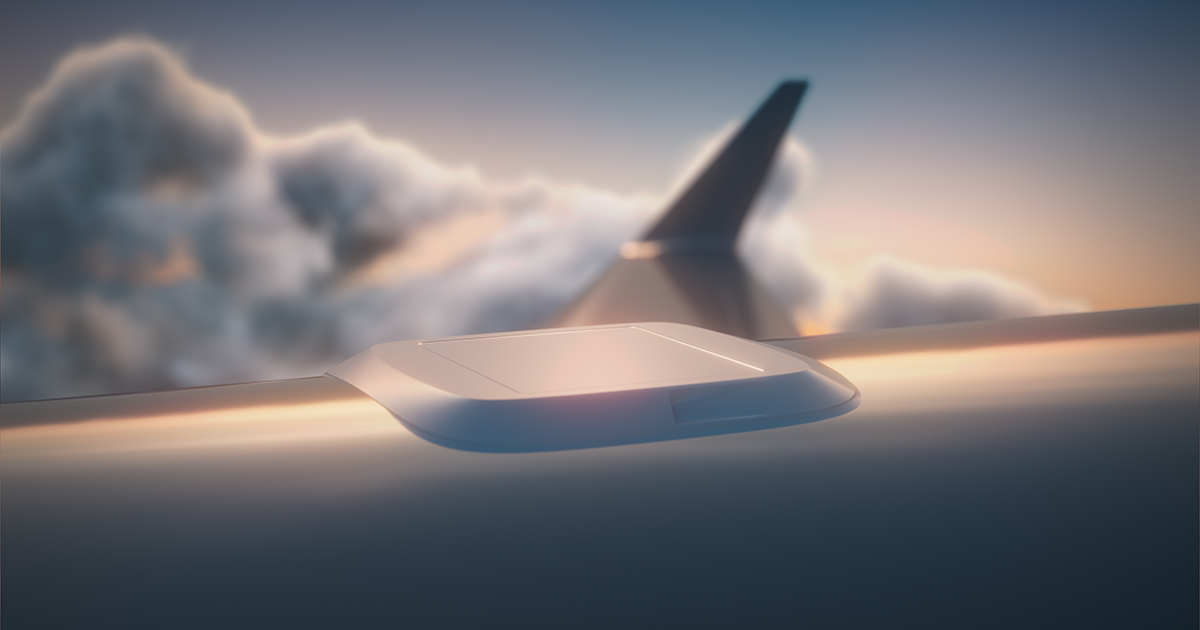
731 Falcon 20B
The Dassault Falcon 20 has always been a great airplane. It has been well received by customers and is also a good looking airplane with just the right proportions. The Falcon 20 was a superb candidate for re-engining and AlliedSignal’s TFE731-5BR retrofit program has certainly been a success. AlliedSignal brought a customer 731 Falcon 20B to VNY (Van Nuys, CA) for our flightcheck along with 731 Falcon 20B Retrofit Program Mgr of Marketing and Sales Don Sterling, AlliedSignal Capt. Rudy Bow and Stjepan Ban, the pilot for the new owner.
Sterling has been involved with the Falcon 20s for 30 years. Additionally, he has been with the re-engining program since it was started 12 years ago and is very knowledgeable about the Falcon 20. Bow is an ex-Air Force F-104 pilot who worked with AlliedSignal on the TFE731 certification program. Ban, chief pilot for the Amsterdam-based owner, was present to talk about his experience with the program.
THE RETROFIT PROGRAM
Transforming a General Electric CF700-2D2-engined Falcon 20F to a AlliedSignal TFE731-5BR powered Falcon 20B yields significant performance improvements. NBAA IFR range is almost doubled from 1405 nm to 2450 nm with the same fuel volume, noise is reduced to Stage III levels and you can cruise 10% faster on trips up to 1445 nm.
The re-engined Falcon 20B also has an improved operational flexibility with 46% more range from a short runway (2000 nm vs. 1370 nm), 73% more range when takeoff weight is limited by maximum landing weight (2317 nm vs. 1340 nm) and 12% shorter takeoff distance for a 1000-nm trip (4000 ft vs. 4550 ft). Rate of climb is boosted from 3330 to 3820 fpm and optimum initial cruise altitude at MTOW improves from 35,000 to 39,000 ft.
Sterling explained that AlliedSignal is primarily involved with the sale of the engine retrofit and thrust reversers. It is the customer’s option on how extensive an upgrade he or she wants to do. A full upgrade on a Falcon 20 would include the $3.78 million engine refit, Dee Howard TR5020 thrust reversers at $370,000, a Rockwell Collins Pro Line 4 EFIS panel at $1.6 million, which includes a choice of long-range nav units, TCAS II, GPWS and high-end HF unit, an AlliedSignal 36-150 APU at $300,000 and a completely new interior for another $700,000. An aft baggage mod, at $47,000, provides an additional 30 cu ft of storage area in the tailcone. The engine change alone involves 15 weeks downtime while the entire upgrade package takes about 25 weeks.
To create a 731 Falcon 20B, a customer brings in their Falcon 20 or they buy one and have the engine, avionics and interior upgrades accomplished at Garrett’s SPI (Springfield IL) completion facility. This work can also be done at Dassault Falcon Jet LBG (Le Bourget, Paris, France) and TSA Transairco GVA (Geneva, Switzerland).
Considering the cost of a good Falcon 20 airframe—about $1.5 million for a standard C model and up to $3 million for a late-model F series—the cost can be almost $9 million with the full upgrade, which is getting close to the price of a new midsize jet. While you’re not buying a new aircraft with this program, the Falcon 20 is an airplane designed with no life limits and, even with a few thousand hours on the airframe, it’s hardly broken in if it has been well maintained. I sincerely believe that a 10,000-hour corporate jet airframe is really nothing to worry about since most people don’t think twice about getting on an airline’s Boeing 747 with 50,000 hours on it. At any rate, the 731 Falcon 20B is a great airplane and AlliedSignal, with the TFE731- 5BR, has the only engine to fit the bill. The TFE731 has the right combination of power and low noise output and there hasn’t been a turbine bizjet engine that’s been more successful.
Sterling considers the Hawker 800, Astra SP, Learjet 60, Cessna Citation VI and GE-powered Falcon 20s competition to the 731 Falcon 20B. In terms of the new-aircraft competition, the Falcon 20B offers the greatest cabin volume (700 cu ft), the longest range (2450 nm), the best climb rate (3820 fpm) and one of the most attractive fuel efficiencies and balanced field lengths.
PROGRAM HISTORY
The Falcon 20 has military roots with its wing, wing attachment system and landing gear derived from the Mystere IV, the last Mystere fighter Dassault built before going into the Mirage series. Charles Lindbergh, acting on behalf of Pan Am World Airways, was impressed with the aircraft at the 1963 Paris Airshow and wired Pan Am Chairman Juan Trippe with a message that read “We have our plane.” Pan Am established a business jet division that same year, placing orders for 40 Falcon 20s with an option for another 120. The General Electric CF700-powered Falcon 20 ultimately sold 500 copies, making it one of the most successful business jets in history. The Falcon 20 was an incredible airplane in the beginning and, in terms of performance and styling, it’s still ahead of many current-generation business jets.
Sterling got involved with the AlliedSignal re-engining program when it started in 1987. He’s been promoting the retrofit program ever since and 103 Falcon 20s have currently been re-engined. About 75% of the Falcon 20B fleet are US based while the remainder are scattered around the world. While there’s a good supply of GE powered Falcon 20 airframes on the market, they have become more challenging to find in today’s market, not to mention more expensive.
PREFLIGHT
As we did our walkaround, Bow pointed out some of the features of the Falcon 20B. The leading edges have full-span slats in two sections and the trailing-link landing gear makes for nice smooth landings. The airplane I was to fly had an external baggage mod that provided additional storage in the tailcone— large enough for three golf bags or big Samsonite suitcases. Access to the avionics racks in the nose is similar to the Falcon 900EX.
The 24-ft passenger cabin is appealing for an aircraft of this category with a nice eight-place layout, a lav and two internal baggage stowage areas totaling 65 cu ft. Depending on the options specified, a customer can have 90 to103 cu ft of total baggage area on their 731 Falcon 20B. At 700 cu ft, the cabin volume of the Falcon 20B is quite a bit larger than the Citation X, Hawker 800 or Learjet 60. One thing I didn’t like about the cabin, however, was the positioning of the windows—they’re so low that the average person can’t look out and see the horizon. On newer series Falcons like the 900EX, the windows have been positioned higher.
The flightdeck was very nice and well organized. This particular aircraft had a Rockwell Collins Pro Line II five-tube EFIS panel. However, beginning with delivery #102, Collins Pro Line IV systems are standard equipment in the avionics upgrade package. Two features I always like about Falcon flightdecks are the positioning of the parking brake in the center of the glareshield and the direct-vision window. Like the Falcon 900EX, the Falcon 20’s direct-vision window can be opened at speeds of up to 160 kts for smoke removal or should you have ice buildup due to windshield heat failure, which is unlikely.
FLYING THE FALCON 20B
We taxied to VNY’s Rwy 16 at a weight of 23,500 lbs, which was 80% of the airplane’s 29,100-lb MTOW, and an outside temperature of 92°F. At that weight, our V2 was 121 kts. We took off and climbed to FL390. While the rate of climb was very good up through FL350, it slowed to about 500 fpm from FL350 to FL390.
We reached FL350 in 19 min but it took eight more min to reach FL390, where we leveled off and accelerated to Mach .75. At FL390, we had a fuel flow of 700 pph per engine. Bow explained that at FL410, cruise fuel flows get down to 650 pph per engine.
ATC gave us a clearance down to 18,000 ft, providing a good opportunity to try the speed brakes. The Falcon 20 has no speed limitations for speed brake deployment. It has no turbulence penetration speed limitations but the gear extension limit is 190 kts. For a rapid descent from cruise, a pilot can simply reduce the power and deploy the speed brakes.
Deploying the speed brakes caused a very slight, but easily controllable, nose-up tendency. With the power reduced, we accelerated to Mmo (Mach .88), descending at a rate of more than 10,000 fpm, and leveled out at 18,000 ft. We were then vectored to BFL (Bakersfield CA) where I set up a VFR pattern for Rwy 30. As the airspeed dropped below 190 kts, I lowered the gear and extended the flaps to 25°. At 160 kts, I deployed full flaps. Our over-the-fence speed on this first landing was 111 kts, the aircraft flared nicely and the Falcon’s trailing-link gear ensured a smooth landing.
I did a touch-and-go and stood the throttles up to 12 o’clock while Bow reset the flaps and trim. Adding full power, we took off and came around for another landing with a short approach. The airplane is very easy to maneuver at approach speeds of 120 kts to 140 kts and visibility from the flightdeck is excellent.
Following our second touch-and-go, Bow cut one engine at V2 and we climbed out single-engine at a very good rate of 1100 fpm to 1200 fpm at our weight of 23,000 lbs. The airplane required heavy rudder pressure with one engine cut but it was easily trimable with the electric trim that was located at the left rear of the pedestal.
We came around again and performed a full-stop landing with a taxi back to the active runway. I found the brakes to be very effective. At our operating weight, we really rolled along at idel power, which necessitated a braking now and then to keep the aircraft’s speed down.
During the next takeoff, Bow cut an engine at V1 and the airplane was easy to control but I was using almost full rudder at V2. Single-engine climbout was 1200 fpm and I brought the power back up at 2000 ft and climbed to 17,500 feet on our way back to VNY. Flying over the east end of Antelope Valley, we performed a couple of turns at 45° banks.
At this point, I slowed the airplane down for a clean stall. The Falcon 20 gives you plenty of aerodynamic warning and, like other Falcons, it does not have, need or require a stick shaker or pusher of any kind. The stall characteristics of the Falcon 20 are excellent—it is even more docile than a Cessna 172.
I tried another stall to see if the aircraft would break. This time, instead of entering stall from level flight, I dropped down, pulled the nose up to a higher angle and applied more elevator input. Even with the control wheel pulled back to the stop, the nose wouldn’t drop—it just kind of mushed. The airplane seemed to have excellent slow flight and stall characteristics, which are inherent in the original Falcon 20 design.
Landing at VNY, I used the reversers without the brakes until we were very slow. We turned off at taxiway 17G, which is only 4000 ft from the displaced threshold. The Dee Howard TR5020 “clam-shell” reversers are very effective. During the taxi, I again noticed the characteristically good ground handling qualities of this aircraft although the wheel for the nosewheel steering is a little awkward for me, which required a long reach forward.
SYSTEMS
Elevator, rudder and ailerons are moved by push-pull rods actuating twin-barreled hydraulic servo-control units. Each barrel is powered by a different hydraulic system—the loss of one system has no effect on flying characteristics. In the unlikely event of total hydraulic failure, the plane can still be flown manually. All three flight control systems have artificial feel units to provide control feedback and each has an electrically controlled trim system. An electro-hydraulic yaw damper is provided but its failure imposes no restriction to airplane operations.
Airbrakes may be extended throughout the complete flight envelope. Flaps are extended 10°, 25° and 40° and are driven by hydraulic motors through jack screws. Slats are full span in two sections and are extended when the flap control is at the 10° position.
Each engine is fed from its respective wing main tank and feeder tank. The main tanks are pressurized by bleed air to ensure a fuel supply in the event of a single or multiple pump failure.
Hydraulic pressure is provided by two engine driven pumps and an electrically driven pump is on standby for vital functions of systems. Pressurization and air conditioning are supplied by bleed air from both engines. A pressure differential of 8.3 psi maintains a sea level cabin to 21,000 ft and an 8000-ft cabin at 42,000 ft.
The electrical system is a 28-volt DC system supplied by a 300-amp starter generator on each engine. An optional AlliedSignal 36-150 APU can also deliver up to 300 amps on the ground and inflight below 30,000 ft. A 115-volt AC system is supplied from three 750-VA static inverters. Two are used for normal operation while the third is a stand-by unit.
Engine intakes are anti-iced with hot bleed air from the respective engine while wing anti-ice is achieved by distributing hot bleed air to the the wing’s leading edges. Tailplane and tailfin anti-icing are not necessary on the Falcon 20. Windshield anti-ice is electric with the three front panels automatically controlled by two independent systems and individual regulators.
MAINTENANCE AND TRAINING
The Falcon 20 maintenance inspection program involves an A check at 300 hours or one year, a B check at 600 hours and a C check every six years. Gear overhaul is at 15 years and a wing plank check every even numbered C inspection. The airframe and components are not life or cycle limited. Flap tracks and the leading-edge extension guides are lifetime titanium assemblies with no replacement requirement.
The engine warranty on a Falcon 20B TFE731-5BR refit is no different from buying a brand-new aircraft— five years or 1800 hours—and a retrofit airplane is considered a new aircraft as far as MSP goes. MSP pricing on the Falcon 20B is $94 per engine per hour.
Maintenance access on the Falcon 20B, like other series Falcons, is easy with nice drop panels, a good rear access panel and a nose that swings out for easy avionics and electrical system access. Two maintenance and pilot training slots are provided by AlliedSignal. Maintenance training involves a two-week school where mechanics participate in a tear down and rebuild of an engine. Pilot engine familiarization involves three days at AlliedSignal in Phoenix. Both FlightSafety and SimuFlite offer specific Falcon 20B recurrent training and FlightSafety has two new dedicated TFE731 Falcon 20B simulators—one at TEB and one at LBG.
RVSM certification for the Falcon 20B is relatively straight-forward. The airplane we flew was the one of the first RVSM-approved Falcon 20s and the approval is not a difficult or expensive procedure. In the case of our flight test aircraft, RVSM approval required new Rosemont pitot-static tubes plus the cost of buying service bulletins from Dassault, which cost about $16,000 for the RVSM certification process.
IMPRESSIONS
I found the 731 Falcon 20B to be a nice flying airplane with performance and handling characteristics equal to any modern day aircraft in its class. The Falcon 20 was a great design and ahead of its time when it came out. With new engines and avionics, the best of the Falcon design with all the efficiency, performance and comfort of a new aircraft are retained.
The 731 Falcon 20B upgrade program is one you should consider if you’re looking at buying this class of airplane. I believe this program will appeal to current Falcon 20 owners that are happy with the airplane. Retrofit customers can go out and spend $3.78 million just on the engines or they can spend $6 to $8 million and have what amounts to a whole new airplane.
I also see good potential for this program if someone were to buy a few Falcon 20 airframes, put them in zero condition with new engines, interior and panel and then offer them off-the-shelf ready to go.
If you do not have a Falcon 20 and are faced with finding an aircraft and then arranging for the upgrade, you’ve got to consider the time involved in the process. You’ll likely spend a few months finding and buying an aircraft and then four to six months for the upgrade process, depending on how far you want to go.
My advice would be that if you’re considering a 731 Falcon 20B, as opposed to buying a new airplane, you should consider going all the way so that you end up with a like-new aircraft with a zero-time air- frame, new interior and avionics. A Van Nuys-based operator did the full job on his Falcon 20 and it’s a beautiful airplane that is just like new. But if you cut corners, there is the possibility of spending $6 million on the project and still ending up with the “used airplane” feel.
The 731 Falcon 20B is a great airplane with a particularly strong suit in flight handling characteristics. It is hard to believe that the Falcon 20 was designed in 1963 and first went into production 33 years ago. Although it has been out of production for some time, the AlliedSignal retrofit program offers you a good-as-new Falcon 20.


